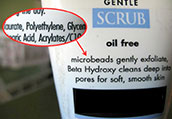 Whether you live in a house connected to a sewer or you use a septic system, it’s very important to limit what you flush down your toilet or pour down your sink. The only things you should flush down the toilet are human waste and/or toilet paper, period. Anything else should go into the trash. Even items labeled “flushable” or that say they are safe for the sewer or septic systems should be discarded in the trash. These items can increase the frequency that you’ll need to pump your septic tank or cause clogs in your pipes, which can cause overflows that can damage property and make people sick.
Whether you live in a house connected to a sewer or you use a septic system, it’s very important to limit what you flush down your toilet or pour down your sink. The only things you should flush down the toilet are human waste and/or toilet paper, period. Anything else should go into the trash. Even items labeled “flushable” or that say they are safe for the sewer or septic systems should be discarded in the trash. These items can increase the frequency that you’ll need to pump your septic tank or cause clogs in your pipes, which can cause overflows that can damage property and make people sick.
Avoid harming water quality, fish and wildlife, and protect your septic or sewer treatment plant by doing the following:
- Disposing of drugs:
Drugs, medications, and other pharmaceuticals should never be flushed or poured down the sink. If you are concerned about keeping medications away from children and pets, first mix them with old coffee grounds or kitty litter before disposing them in the garbage. Some pharmacies and police stations accept narcotics and other prescription drugs for free and safe disposal.
- Disposing of chemicals:
Never pour harsh cleaning products, chemicals, solvents, antifreeze, automotive fluids, cements and glues, nail polish remover, or pesticides into the toilet or down the sink. Do not use the sink to clean up after painting, whether the paint is oil or water based. Paints can harm your septic system, and if you are connected to sewer the paints may enter Puget Sound and harm marine life. Check with your solid waste facility to see if they accept any of these items; many offer free disposal of hazardous substances.
- Microplastics in personal care products:
Many common products used in the home contain tiny beads of plastic, called microplastics. These products include toothpaste, deodorants, eye shadow, exfoliates, body washes, and abrasives used in hand-washing products. The tiny beads wash down the drain, through the filters at the sewage treatment plant, and into the water. These microplastics can be ingested by marine life, sickening or killing them. Avoid purchasing or using products that may contain microplastic beads. Look for the ingredient polyethylene. If the word is followed by a comma, you may have found a source of microplastics.
Shellfish, such as oysters, mussels, and clams are filter feeders that subsist by eating tiny particles floating in the water. Bacteria found in the feces of humans and other warm-blooded animals are monitored in recreational and shellfish harvesting areas because they are good indicators that other harmful pathogens may be present. When high bacteria levels are found, beaches are closed to shellfish harvesting and swimming.
How to know when water is polluted
Bacterial pollution monitoring is conducted by the Washington Department of Health, the Washington Department of Ecology, and by some counties, tribes, and local municipalities. In a given area the monitoring is often well coordinated and done on a regular basis at various locations. Unfortunately, monitoring is expensive and is often only done on a monthly basis, which may not catch contamination quickly enough to prevent harm. Before you harvest shellfish call the hotline at 1-800-562-5632 to see the status of your beach or visit the Washington Department of Fish and Wildlife website at: wdfw.wa.gov/fishing/shellfish.